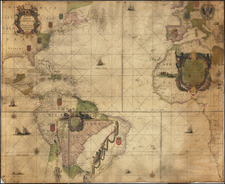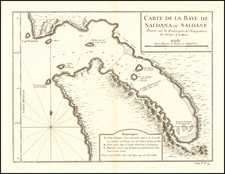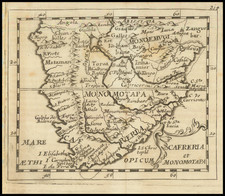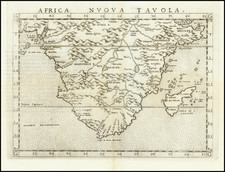The Outbreak of the Eastern Cape's Final Frontier War. The Beginning of the End for Black Independence in South Africa.
Important manuscript map of the Eastern Cape region in the vicinity of East London, annotated with extensive information about settlers and tribes and showing the area contested during the Ninth Xhosa War (1877-1879).
The map shows the region between East London and Queenstown and extends to the more rural north. The amount of information on the map is impressive. Not only are the major geographical features shown, but also a plethora of additional information of military importance. Tribal limits are mapped, every Cape settlement is shown (including farms), tribal police stations are denoted and landing spots along the coast are marked. Notes about the tribes abound, including one reading "former stronghold of Gaikas & others warkke tribes now occupied by friendly Fingoes." Given the context in which this map was made, it was almost certainly produced for governmental forces or administrators arriving in the region during the start of hostilities and based on local information.
The map was produced during the start of the Ninth Xhosa War, a conflict critical to the development of the Eastern Cape and the confederation of South Africa. The war, which started with a bar fight, saw local settlers successfully convince imperial British troops to participate in what was, originally, an inter-tribal conflict. This was against the wishes of the Cape Government in Cape Town, which had just, in 1872, gained the right of self-governance, with ministers reporting to the elected parliament, rather than appointed British governors. The Cape Government at the time strongly opposed the idea of confederation, which would have brought all of South Africa, including tribal areas, under British imperial control. However, the British governor's role in the war led to twenty years of "Confederation Wars," which culminated in the Second Boer War of 1899-1902 and British control over all of South Africa.
Dating the Map
The map shows a railroad from East London to King Williams (Qonce) and a proposed line on to Queenstown. This is the nascent Cape Eastern Line, which was built to reach the South African Frontier and a string of British military forts. Construction on the line was begun in August of 1872 and reached Queenstown in 1880. The network of tribal police stations is shown, but no imperial military outposts, suggesting that this map is from immediately prior to the outbreak of the war.
The Ninth Xhosa War and the Eradication of the Final Independent Xhosa Kingdom
The Ninth Xhosa war was fought between 1877 and 1879 by white settlers, imperial troops, and their ethnic allies (predominantly the Fengu, shown as the "Fingoes") against the Gcaleka Xhosa (shown as the "Gaika") people and their allies. The war saw the final Xhosa kingdom eradicated and paved the way for both the settling of the interior of the Eastern Cape and continued British imperialist domination over the colonies. The war was fought exclusively in the area shown on the map and terminated in the Amatola Mountains (shown just west of Fort Cunningham).
The war was precipitated by a significant drought that started in 1875 and inflamed rival ethnic factions. The first conflict of the war was a bar fight following a wedding celebration when Gcaleka and Fengu attendees had a dispute, this escalated into a Gcaleka attack on a Fengu police station. This continued escalating, and white settlers divided into two different camps as to how to respond. The Cape Government wanted the matter to be left to local police chiefs and commandos, while local settlers and imperial representatives, keen on expanding into Gcaleka territory, wanted to turn the fight into a casus belli for territorial acquisition. This would require bringing in imperialist troops.
The Cape commandos initially saw strong successes and were quickly recalled to be disbanded, with the Cape Government's aims of pacification achieved. However, Henry Bartle Frere, British colonial governor, established a war council in East London and sought to push the conflict further so as to turn the war into one of conquest. After the withdrawal of Cape commandoes, he ordered the disarmament of all Black individuals in the area, much to the horror of the many black soldiers and the Cape Government. The subsequent mass desertion of the local militias was argued as necessitating imperial troops to be brought in.
The British troops faced many disastrous defeats, being outmaneuvered by guerilla tactics. After over a year of fighting, the troops finally managed to organize a system to combat these tactics and destroyed the Gcaleka forces. Their lands became administered as a British territory.
This was the first of the Confederation Wars, which lasted for the next twenty years and culminated in the great Anglo-Boer War. This saw the unification of South Africa under British rule.










![(South Africa) Jeppe's Map of the Transvaal or S.A. Republic and Surrounding Territories [Six-Sheet Map]](https://storage.googleapis.com/raremaps/img/small/84245.jpg)
![[Oranje Freistaat, Transvaal and Kap Kolonie Game Board]](https://storage.googleapis.com/raremaps/img/small/80146.jpg)


